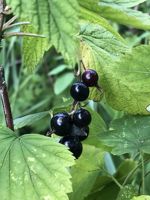Mon-Fri 9am - 5pm Mountain time
American Black Currant vs Bilberry
Ribes americanum
Vaccinium myrtillus
CUSTOM GROW
CUSTOM GROW
American Black Currant is a native deciduous shrub known for its clusters of small black berries that ripen in mid-to-late summer. The berries are edible and have long been used for fresh eating, preserves, and baking. They provide food for birds and mammals, and their fragrant spring flowers attract bees and other pollinators.
American Black Currant’s foliage serves as a host plant for butterfly species such as the Green Comma and Gray Comma, and its dense branching offers cover for wildlife. The shrub has traditionally been planted in shelterbelts, riparian buffers, and restoration projects.
Bilberry is a native perennial shrub valued for its small, blue-black berries that ripen in mid to late summer. The berries resemble blueberries but have a richer, more tart, and intense flavor. They have long been used for fresh eating, baking, and preserves, while also providing food for birds and mammals. In spring, its delicate pinkish flowers attract bees and other pollinators.
Growing low to the ground, Bilberry forms spreading colonies that create dense understory cover. This growth habit provides food and shelter for wildlife, and its foliage adds seasonal interest by turning red to purple in autumn. With its adaptability and ecological benefits, Bilberry is well-suited for naturalization, ecological restoration, and pollinator gardens.
American Black Currant Quick Facts
Bilberry Quick Facts
Toxicity: leaves may be unsafe in high doses

